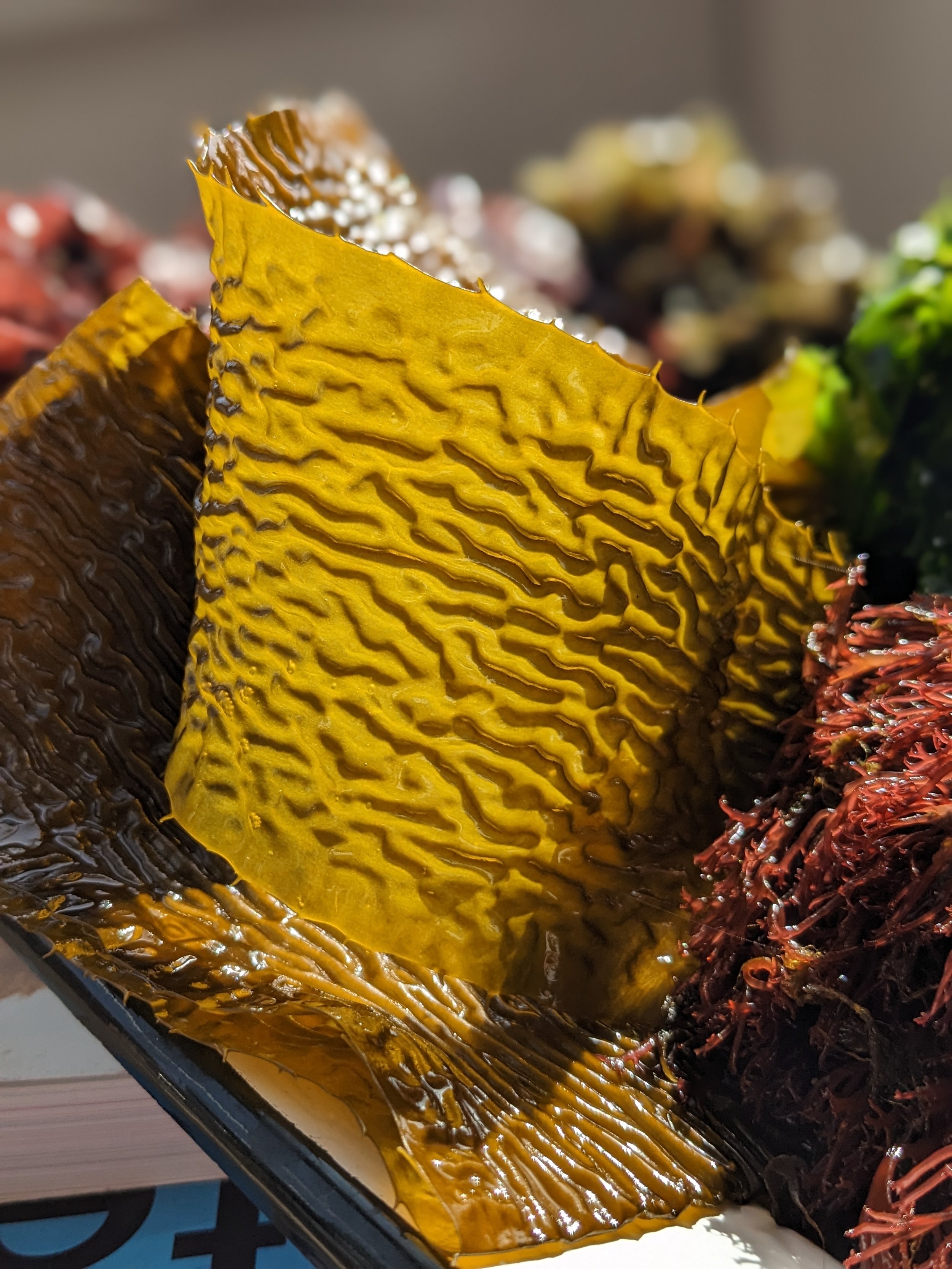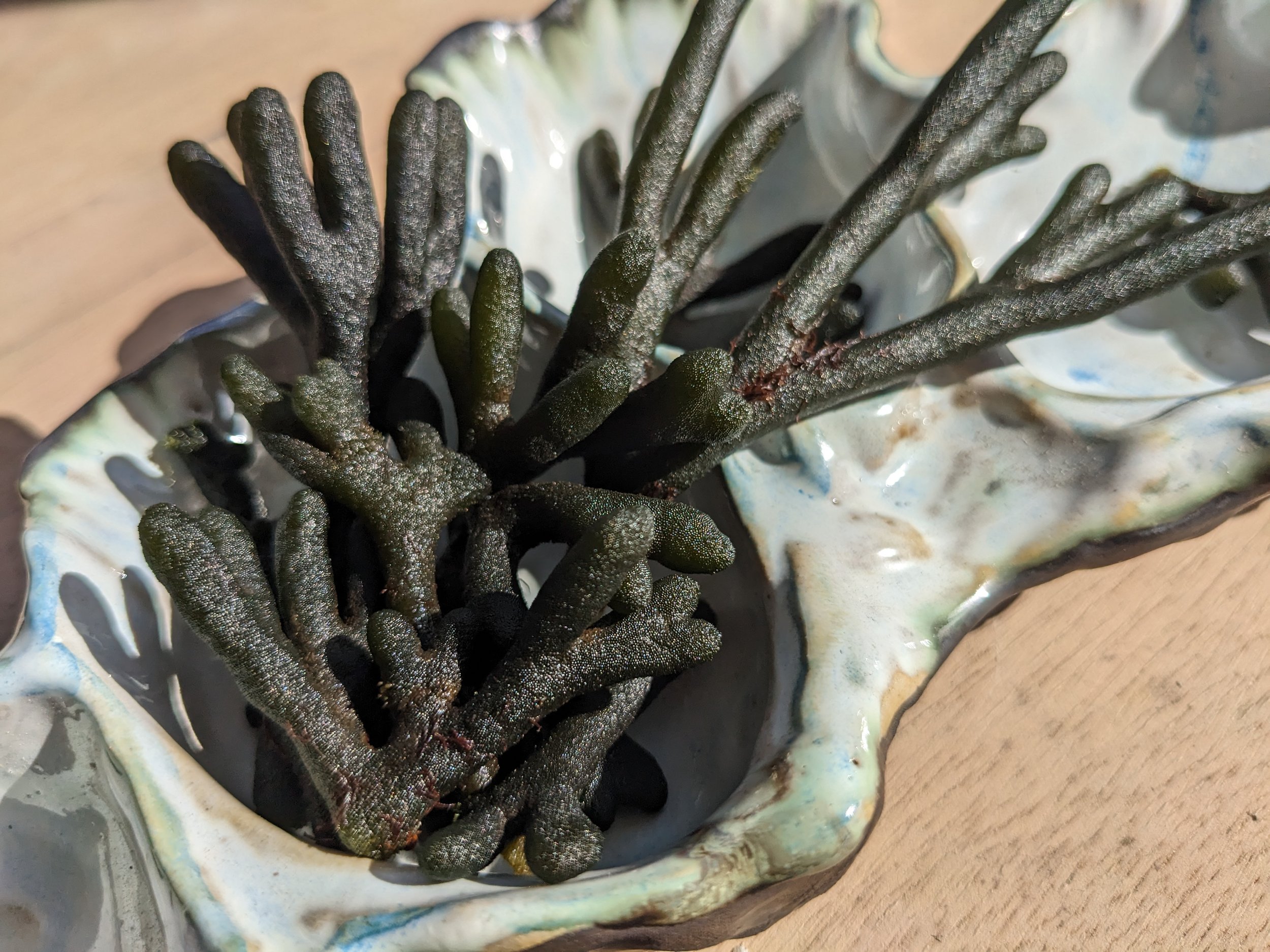Live Seaweed Selection
Dulse — Kombu — Ogo — Sea Lettuce — Red Sea Grapes — Velvet Horn — Nori Leaf
Fresh Leaf Nori
Dulse - Dulse is a thicker brownish variety of red seaweed that is known for its 'bacon-like' flavor when fried. It can be used raw, steamed, fried or used to make a flavorful broth. When the dulse is cooked it will lose its reddish-brown color and turn to a deep green. Dulse will become very crisp when fried and served as bar snacks, crumbled over other ingredients or used as structured layers to create a beautiful modern look. With a deep umami taste, we have used dulse to create broths used in innovative cocktails and as simple additions to traditional drinks such as an Ooh Mommy Bloody Mary.
Ogo - Crisp, light and salty, ogo seaweed is often found as a signature ingredient in Hawaiian poke preparations. Ogo is also known as limo in some markets in Hawaii. It has a fluffy texture and a deep reddish-brown color when fresh. Ogo is wonderful when served raw in salads, in cold broths, with shellfish preparations and with ceviches or sushi. When cooked, ogo turns from a reddish-brown to a deep green color. It can be steamed or used in cold infusions. Pastry chefs should play with the jellifying properties of ogo, as it is one of the seaweeds used to make agar. Besides creating interesting textures in desserts, the fresh ogo will add a unique dimension and enhancement to other flavors.
Sea Lettuce - Green sea lettuce is a delicate variety of seaweed. With a delicate sheet like structure and bright emerald green color, it adds a clean crisp taste and visual aspect to dishes. Sea lettuce can be used to wrap fish, added to salads or soups and can even be used in cocktails. When stored cold in seawater, shelf life typically is 4 days. Can be dried, pickled or frozen to increase shelf life.
Leaf Nori - f you haven't tried fresh nori, its great and very different than dried nori paper. Can serve it fresh, pickled, dried, roasted, or even fried (pictured here) to add great flavor to salads, soups, breads, breading or make your own furikake. Leaf nori comes in delicate ribbons. Check out the picture above. High in protein, low in carbohydrates and fats, and loaded with ocean nutrients (e.g., iodine, chlorophyll, anti-oxidants. When stored cold in seawater, shelf life typically is 7 days. Can be dried, pickled or frozen to increase shelf life.
Kombu Blades - Live (fresh) kombu is rare! It can be used to cure fish, enjoyed raw, roasted, in soups or smoked! Beautiful large leaves or blades have a rippled texture and a dark green “stained glass” characteristic. This is an opportunity for your culinary imagination to go wild! Why buy the whole kelp frond when all you need is the blades? Our fresh kombu blades are rich in flavor, perfect in form, and excellent for wrapping fish. Can be braised, blanched or pickled. When stored cold in seawater, shelf life typically is 7 days. Can be dried, pickled or frozen to increase shelf life.
Sea Grapes - These are the red sea grapes native to California. They have a bright pop in the mouth and shine brightly like little gems from the ocean. Perfect for oyster garnishes and craft cocktails. Exceptional flavor, exceptional texture and color. Fresh California red sea grapes (Botryocladia pseudodichotoma) are a crazy cool fresh seaweed with bright red stems and pea-sized red vesicles filled with a sugary brine. They pop in your mouth like vegan caviar!!! Best served cold and fresh, as a unique edible garnish on oysters, or in specialty cocktails! Due to their fluid-filled vesicles, our sea grapes can be pickled, but they cannot be dried or frozen.
Velvet Horn - Fresh velvet horn (Codium fragile), is a very unique product. Dark green with a shape unlike its natural counterpart, becoming “horned” when grown in our tumble-culture system. A soft, velvety chew with an earthy texture, its a special seaweed for a special project! Best fresh or braised … a little goes a long way. Velvet horn can be dried or frozen to increase shelf life, but its texture changes when preserved. Velvet Horn refers to the similarity in shape and apparent texture to a deer’s antlers when first grown and covered in velvet-like skin.














